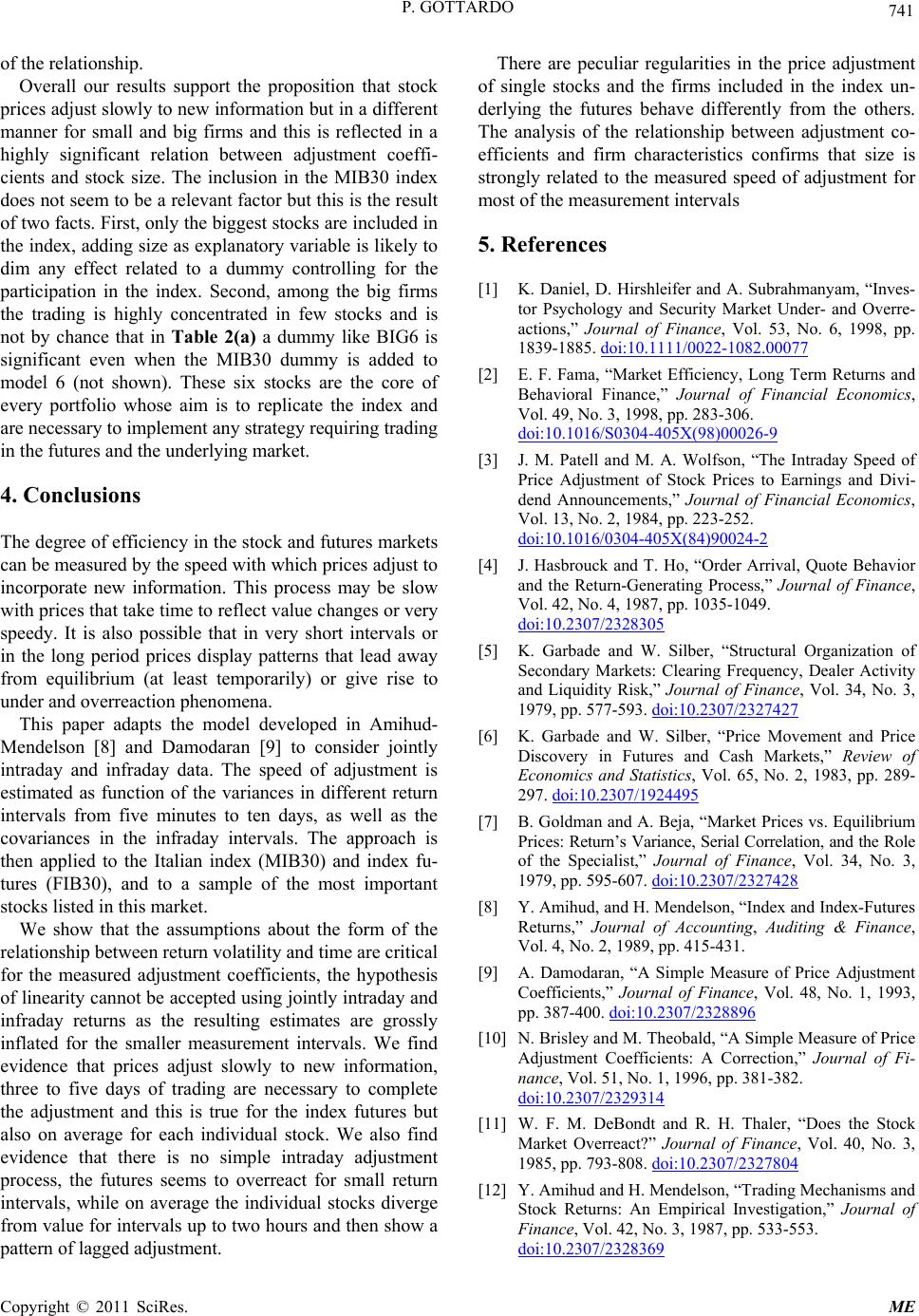
P. GOTTARDO 741
of the relationship.
Overall our results support the proposition that stock
prices adjust slowly to new information but in a different
manner for small and big firms and this is reflected in a
highly significant relation between adjustment coeffi-
cients and stock size. The inclusion in the MIB30 index
does not seem to be a relevant factor but this is the result
of two facts. First, only the biggest stocks are included in
the index, adding size as explanatory variable is likely to
dim any effect related to a dummy controlling for the
participation in the index. Second, among the big firms
the trading is highly concentrated in few stocks and is
not by chance that in Table 2(a) a dummy like BIG6 is
significant even when the MIB30 dummy is added to
model 6 (not shown). These six stocks are the core of
every portfolio whose aim is to replicate the index and
are necessary to implement any strategy requiring trading
in the futures and the unde rl ying m a rk et .
4. Conclusions
The degree of efficiency in the stock and futures markets
can be measured by the speed with which prices adjust to
incorporate new information. This process may be slow
with prices that take time to reflect value changes or very
speedy. It is also possible that in very short intervals or
in the long period prices display patterns that lead away
from equilibrium (at least temporarily) or give rise to
under and ov erreaction phenomen a.
This paper adapts the model developed in Amihud-
Mendelson [8] and Damodaran [9] to consider jointly
intraday and infraday data. The speed of adjustment is
estimated as function of the variances in different return
intervals from five minutes to ten days, as well as the
covariances in the infraday intervals. The approach is
then applied to the Italian index (MIB30) and index fu-
tures (FIB30), and to a sample of the most important
stocks listed in this market.
We show that the assumptions about the form of the
relationship between return volatility and time are critical
for the measured adjustment coefficients, the hypothesis
of linearity cannot be accepted using jointly intraday and
infraday returns as the resulting estimates are grossly
inflated for the smaller measurement intervals. We find
evidence that prices adjust slowly to new information,
three to five days of trading are necessary to complete
the adjustment and this is true for the index futures but
also on average for each individual stock. We also find
evidence that there is no simple intraday adjustment
process, the futures seems to overreact for small return
intervals, while on average the individual stocks diverge
from value for intervals up to two hours and then show a
pattern of lagged adjustment.
There are peculiar regularities in the price adjustment
of single stocks and the firms included in the index un-
derlying the futures behave differently from the others.
The analysis of the relationship between adjustment co-
efficients and firm characteristics confirms that size is
strongly related to the measured speed of adjustment for
most of the measurement intervals
5. References
[1] K. Daniel, D. Hirshleifer and A. Subrahmanyam, “Inves-
tor Psychology and Security Market Under- and Overre-
actions,” Journal of Finance, Vol. 53, No. 6, 1998, pp.
1839-1885. doi:10.1111/0022-1082.00077
[2] E. F. Fama, “Market Efficiency, Long Term Returns and
Behavioral Finance,” Journal of Financial Economics,
Vol. 49, No. 3, 1998, pp. 283-306.
doi:10.1016/S0304-405X(98)00026-9
[3] J. M. Patell and M. A. Wolfson, “The Intraday Speed of
Price Adjustment of Stock Prices to Earnings and Divi-
dend Announcements,” Journal of Financial Economics,
Vol. 13, No. 2, 1984, pp. 223-252.
doi:10.1016/0304-405X(84)90024-2
[4] J. Hasbrouck and T. Ho, “Order Arrival, Quote Behavior
and the Return-Generating Process,” Journal of Finance,
Vol. 42, No. 4, 1987, pp. 1035-1049.
doi:10.2307/2328305
[5] K. Garbade and W. Silber, “Structural Organization of
Secondary Markets: Clearing Frequency, Dealer Activity
and Liquidity Risk,” Journal of Finance, Vol. 34, No. 3,
1979, pp. 577-593. doi:10.2307/2327427
[6] K. Garbade and W. Silber, “Price Movement and Price
Discovery in Futures and Cash Markets,” Review of
Economics and Statistics, Vol. 65, No. 2, 1983, pp. 289-
297. doi:10.2307/1924495
[7] B. Goldman and A. Beja, “Market Prices vs. Equilibrium
Pri ces: Return’s Variance, Serial Correlation, and the Role
of the Specialist,” Journal of Finance, Vol. 34, No. 3,
1979, pp. 595-607. doi:10.2307/2327428
[8] Y. Amihud, and H. Mendelson, “Index and Index-Futures
Returns,” Journal of Accounting, Auditing & Finance,
Vol. 4, No. 2, 1989, pp. 415-431.
[9] A. Damodaran, “A Simple Measure of Price Adjustment
Coefficients,” Journal of Finance, Vol. 48, No. 1, 1993,
pp. 387-400. doi:10.2307/2328896
[10] N. Brisley and M. Theobald, “A Simple Measure of Price
Adjustment Coefficients: A Correction,” Journal of Fi-
nance, Vol. 51, No. 1, 1996, pp. 381-382.
doi:10.2307/2329314
[11] W. F. M. DeBondt and R. H. Thaler, “Does the Stock
Market Overreact?” Journal of Finance, Vol. 40, No. 3,
1985, pp. 793-808. doi:10.2307/2327804
[12] Y. Amihud and H. Mendelson, “Trading Mechanisms and
Stock Returns: An Empirical Investigation,” Journal of
Finance, Vol. 42, No. 3, 1987, pp. 533-553.
doi:10.2307/2328369
Copyright © 2011 SciRes. ME